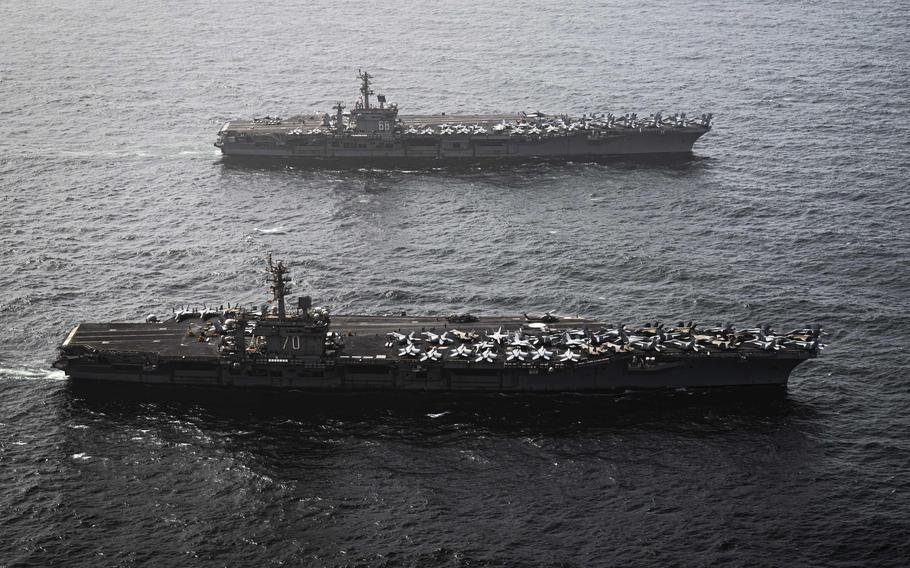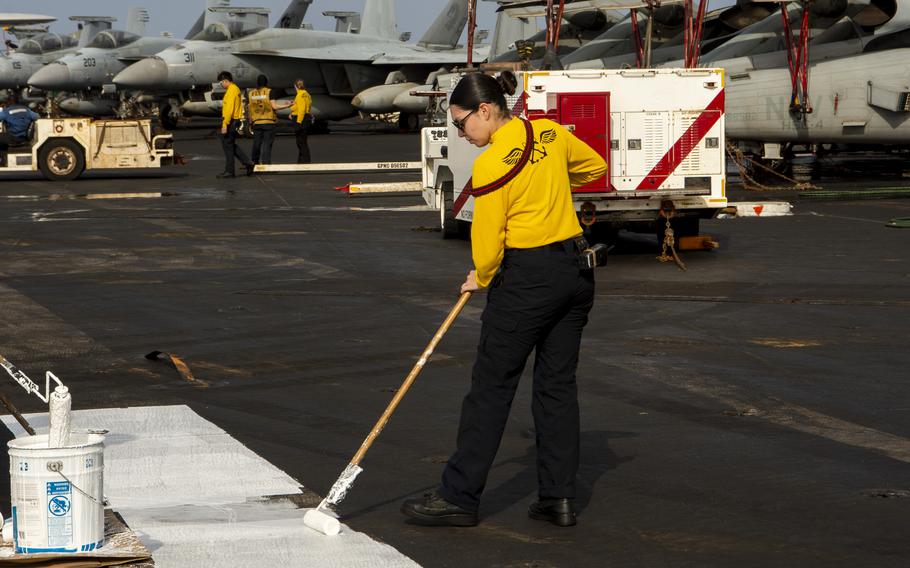
The aircraft carriers USS Carl Vinson, foreground, and USS Nimitz operate in the U.S. Central Command area of responsibility on July 5, 2025. Vinson has since left the area and is now in the Indian Ocean. (Hannah Kantner/U.S. Navy)
NAPLES, Italy — An American aircraft carrier’s departure from the Middle East comes alongside a reduction in Navy forces in the eastern Mediterranean Sea as regional tensions continue to simmer.
The USS Carl Vinson was operating in the Indian Ocean on Monday after about three months in the U.S. Central Command area of operations, USNI News reported.
Vinson’s departure leaves the aircraft carrier USS Nimitz and at least two destroyers in the Middle East at a time when Iran-backed Houthi rebels in Yemen have resumed their attacks on shipping in the Red Sea.
Those assaults earlier this month presumably killed four mariners and sank two commercial ships.
They came just two months after President Donald Trump declared a ceasefire with the Houthis in the wake of a punishing U.S. airstrike campaign aimed at stopping the group’s attacks on commercial and military ships in the vital waterway.
On Monday, Nimitz was operating in the Arabian Sea, and the destroyers USS Truxton and USS Forest Sherman were in the Red Sea. The littoral combat ship USS Canberra is operating in the Persian Gulf on a rotational deployment, according to USNI.
The U.S. has not maintained a carrier presence in the Red Sea since the departure of the USS Harry S. Truman in May.
Analysts say it likely would take a significant escalation to bring the U.S. back into a war with the Houthis, who have framed the strikes as part of their conflict with Israel.
“I assume the U.S. won’t intervene unless the attacks return to the scale and momentum seen before its spring military campaign against the Houthis,” Nadwa Al-Dawsari, a fellow at the Geneva-based Center on Armed Groups, told Stars and Stripes earlier this month.
The U.S. considers the truce still in effect as long as the Houthis do not take aim at American ships, The Wall Street Journal reported on July 10, citing an unidentified U.S. senior official.
The Houthis began their campaign against ships in the Red Sea and the Gulf of Aden in November 2023 following Hamas’ attack on Israel the previous month.
Meanwhile, the Navy has reduced the number of destroyers in the eastern Mediterranean from five to one. On Monday, the USS Arleigh Burke, homeported in Rota, Spain, was on patrol in the sea.
The apparent force reduction followed a surge of destroyers sent to the eastern Mediterranean as increasing hostilities between Israel and Iran in June threatened to ignite a broader conflict in the Middle East.
The ships were sent to the region to help defend Israel against Iranian attacks and promote regional stability, the Navy said in a statement last month.
The 12-day war ended in a ceasefire on June 24. Days before, the U.S. bombed three Iranian nuclear facilities.
The region soon could see another aircraft carrier, though. USS Gerald R. Ford left the U.S. on June 24 for a scheduled deployment to the U.S. 6th Fleet area of operations, which includes the eastern Mediterranean.
In January 2024, Ford completed a deployment of about eight months that included the eastern Mediterranean and Middle East. Ford is in the Atlantic Ocean, USNI reported on Monday.

Petty Officer 2nd Class Sitley Deleon applies a fresh coat of paint to the landing lanes on the flight deck of the aircraft carrier USS Carl Vinson on July 11, 2025. The ship is underway in the Indian Ocean after leaving the Middle East. (Marissa Johnson/U.S. Navy)
Stars and Stripes reporter Lara Korte contributed to this report.